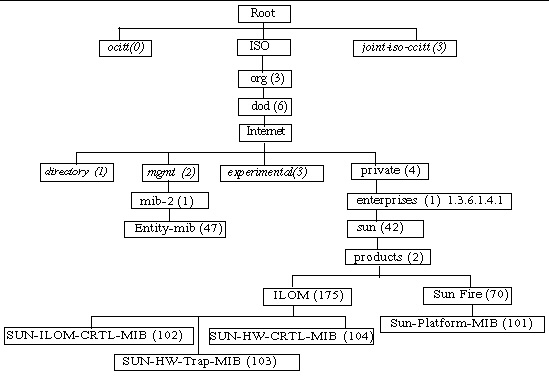| C H A P T E R 1 |
|
SNMP Overview |
|
Learn about preparing your system to use SNMP, SNMP components, and SNMP MIBs |
|
|
Oracle Integrated Lights Out Manager (ILOM) 3.0 Concepts Guide
|
||
|
Oracle Integrated Lights Out Manager (ILOM) 3.0 CLI Procedures Guide
|
||
|
Oracle Integrated Lights Out Manager (ILOM) 3.0 Web Interface Procedures Guide (820-6411) |
||
|
Oracle Integrated Lights Out Manager (ILOM) 3.0 Management Protocols Reference Guide (820-6413) |
||
|
The ILOM 3.0 Documentation Collection is available at: http://docs.sun.com/app/docs/prod/int.lights.mgr30#hic |
||
ILOM supports the Simple Network Management Protocol (SNMP), which is used to exchange data about network activity. SNMP is an open, industry-standard protocol technology that enables the management of networks and devices, or nodes, that are connected to the network. Using SNMP, data travels between a managed device (node) and a management station with network access. A managed device can be any device that runs SNMP, such as hosts, routers, web servers, or other servers on the network. SNMP messages are sent over IP using the User Datagram Protocol (UDP). Any management application that supports SNMP can manage your server.
For a more complete description of SNMP, see the SNMP five-part, introductory tutorial available at:
http://www.dpstele.com/layers/l2/snmp_l2_tut_part1.php
ILOM supports SNMP versions 1, 2c, and 3. Using SNMP v3 is strongly advised since SNMP v3 provides additional security, authentication, and privacy beyond SNMP v1 and v2c.
SNMP is a protocol, not an application, so you need an application to utilize SNMP messages. Your SNMP management software might provide this functionality, or you can use an open source tool like Net-SNMP, which is available at:
http://net-snmp.sourceforge.net/
| Note - ILOM users reading this document are assumed to have a working knowledge of SNMP. SNMP client-side commands are used in this text as examples of using SNMP. Users who do not have a working knowledge of SNMP should complete the tutorial at: http://net-snmp.sourceforge.net/wiki/index.php/Main_Page
This tutorial is more advanced than the introductory tutorial referred to above. |
To prepare your system to use SNMP, you must download and install the latest version (version 5.2.1 or higher) of Net-SNMP that works with the operating system of your management station or the SNMP tool of your choice.
For more information about preparing your system to use SNMP, see one of the following guides:
SNMP functionality requires the following two components:
SNMP is the protocol used to communicate management information between management stations and SNMP agents.
The SNMP agent is preinstalled on your Oracle Sun server platform and runs on ILOM, so all SNMP management occurs through ILOM. To utilize this feature, your operating system must have an SNMP client application.
Both management stations and agents use SNMP messages to communicate. Management stations can send and receive information. Agents can respond to requests and send unsolicited messages in the form of traps. Management stations and agents use the following functions:
The base component of an SNMP implementation is the Management Information Base (MIB). A MIB is a text file that describes a managed node’s available information. This tree-like, hierarchical system classifies information about resources in a network as a list of data objects, each with a unique identifier, or object ID. Thus, the MIB defines the data objects, or variables, that the SNMP agent can access. When a management station requests information from a managed node, the agent receives the request and retrieves the appropriate information from the MIBs. In ILOM, the MIB makes it possible to access the server’s network configuration, status, and statistics.
As of ILOM 3.0.4, SNMP MIBs are a part of the ILOM firmware. You can download MIBs directly from ILOM. For more information about MIBs, and instructions for downloading MIBs from ILOM, see the following guides:
FIGURE 1-1 shows the standard MIB tree and the location of the ILOM MIB modules in that tree. The ILOM MIB modules are highlighted in boldface text.
FIGURE 1-1 Location of ILOM MIB Modules

TABLE 1-1 provides a description of the ILOM MIB modules and lists the object ID for each MIB name.
Portions of the standard MIBs listed in TABLE 1-2 are implemented by ILOM.
TABLE 1-3 describes MIBs that are used in support of the ILOM SNMP implementation.
Copyright © 2010, Oracle and/or its affiliates. All rights reserved.